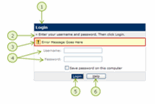Information architecture is the structure and navigation of a Web site or Web-based application. A well-designed information architecture provides effective, goal-oriented interactions between users and the Web site or Web application and helps answer questions such as:
- How will users find information on the site?
- How many steps will it take to complete a transaction (for first-time and repeat site visits)?
- How will a user know where they are in a site at all times?
- Is a site's content just "sitting there," or is it structured to actively drive users toward an end goal?
How It Benefits You
- Users can quickly understand the structure of your Web site or application. Content categories (taxonomy), navigation structure, and vocabulary (nomenclature) are organized in a way that is intuitive and predictable to users.
- Users spend less effort finding information they need.
- Customer satisfaction increases and frustration with the software decreases.
- Customer retention increases.
- More users complete their tasks successfully (for example, there are fewer abandoned shopping carts and more completed transactions).
- At all times, users can easily identify where they are and where they came from within the site.
What We Do
To design an effective information architecture, we first focus on understanding the target user and identifying their goals and tasks that must be supported by the web site or application. For this stage, we use one or more of the following information-gathering activities:
- Discovery meetings to understand the site or the application goals, branding, and other critical issues.
- Interview subject-matter experts on your team and/or real application users to understand users' needs and tasks.
- Goal and task analysis of how various audiences might interact with the system (and identification of ways to streamline that interaction).
- Create content inventory of the current site.
- Conduct benchmark usability testing to identify problem areas for users in completing key tasks.
Using this information, we group the site content it into a logical and streamlined organization, using techniques such as card sorting and card-assignment among others. The goal is to organize the site around readily understandable interaction models, with the structure being neither too broad nor too deep, but intuitive and inviting further exploration.
From this site organization, the site's navigation logically follows. Often, multiple navigation paths are provided to support a diversity of audiences and tasks. We also develop labeling systems that provide a strong "scent" for information and invite site exploration. We may also design information on individual pages to facilitate navigational flow by making certain options particularly salient. Finally, we design supplemental navigational systems such as search/browse systems and site maps.
Deliverable
The main deliverable for depicting the information architecture is a site map. Site maps are graphical representation of the site's structure and show the following:
- the overall content organization
- primary site navigation
- secondary and/or tertiary site navigation
- work flow for "transactional" site areas (e.g., registration or checkout processes on an e-commerce site)
Where necessary, site maps maybe accompanied by sketches of content layouts for important pages on the site such as home page, navigational landing pages, and so forth.



